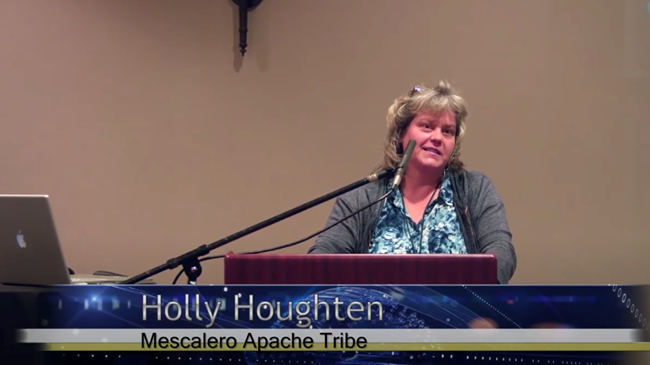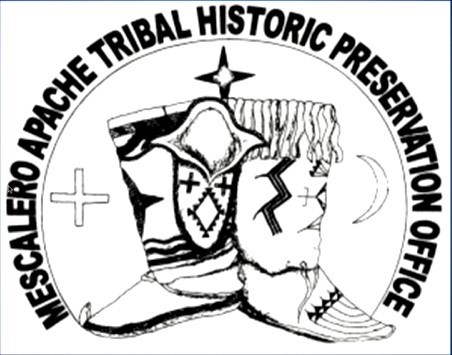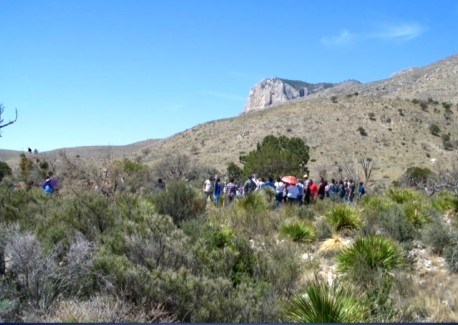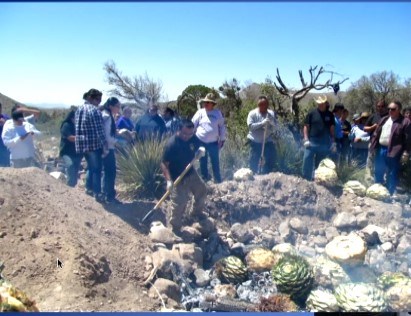Last updated: April 7, 2025
Article
Tribal Cultural Landscapes: Beyond Archeological Sites
National Center for Preservation Technology and Training
This presentation, transcript, and video are of the Texas Cultural Landscape Symposium, February 23-26, Waco, TX. Watch a non-audio described version of this presentation on YouTube.

Holly Houghten, Mescalero Apache Tribe
Holly Houghten: I'm very pleased to have been invited to be here, being a tribal representative. I would've liked to have seen a few more here because with cultural landscapes, it's very important to think about the prehistoric and even the current use that Tribes have of the different areas. I wanted to start just a little to give you guys just a little background on the Mescalero Apache Tribe real quick, just since some of you may not be familiar.
We're located in South Central, New Mexico. The reservation was established in 1873. Currently we have almost 5,000 tribal members. But one thing to note is the tribe is made up of three different bands of Apaches: the Chiricahua, Mescalero and Lipan. We are the only federally recognized Lipan Tribe. There are a couple of groups here in Texas that claim to be state recognized as Lipan but if you're consulting on Lipan issues, we're the Tribe that you should be consulting with.
This is our office logo and it has the three different bands, moccasin styles: Chiricahua, Lipan and Mescalero. My reservation ranges from very high areas, we have a ski area, and then down to the lower portion, which is mostly desert scrub, woodland area.

Holly Houghten, Mescalero Apache Tribe
We have a lot of natural resources. We have a fish hatchery, timber, and a lot of different things. The Apaches were mobile hunters and gatherers, originally covering a very large territory in of the three different bands that I'd mentioned. Our traditional homelands cover most of New Mexico, Arizona and Texas and spreads a little bit into Colorado and down into Mexico.
When they were put on the reservation, that changed and altered the whole Apache lifestyle. Mobility was not allowed to occur anymore and also hunting and gathering were restricted, and they were forced to try to farm. Also, it affected the culture in many ways, however, the culture continued to persist and maintain strong and still is today.
So, one thing I want to talk about a little bit is consulting with Tribes. We aren't only interested archeological sites. Consultation started in the later '90s, and most of the time, all we were sent were reports of archeological sites or surveys. But tribes look at the whole landscape of a project and also the areas around it. So that's one thing we'd like to have you keep in mind.

Holly Houghten, Mescalero Apache Tribe
We're not interested in just protecting archeological sites, to us, the culture expands out into the landscape: the water, rocks, minerals, terrain, vegetation , among other things. When I first started working with the tribe we would mostly just get archeological reports, or if we would go to a meeting with the agency, it's the same thing. "Well, these are the types of sites we have that are possibly affiliated to your tribe." But we'd say, "Well, what kind of animals do you have here within your public land? What sort of plants are growing here? And springs? Those are all things that are equally important that we'd like to know about."
So today, we're mostly here to talk about cultural landscapes. And if you were to ask most Native Americans what do you consider a cultural landscape? It would be about everything out there, you could make the whole world a cultural landscape. But it is something that tribes are very happy to hear about because again, it's not just looking at those archeological sites. So the definition of a cultural landscape fill, as I said, the overall tribal view of the world. It's the interaction of the cultural and the natural together.
The two most common types that tribes would define would be historic and the ethnographic landscape, but that isn't something that I want to see you limiting your consultation with tribes concerning landscapes. Because maybe it is an urban development, a certain hotel within a community or something, but a tribe that was within that area at that time may have a cultural association with it, as well. Perhaps it was a place where they could go and sell some of their artwork or to get outside work to help that community. There are a lot of different aspects of the tribal culture that may have been impacted by urban development, so you should also consider that. Same with a mining district. Again, it could have been that it had an effect and it is a part of the change in the cultural landscape for tribe because perhaps then they were cut off from actually going into that area because the mine was developed. Or again, trade may have been then able to occur because there were a lot of people that were brought in and that they could start to trade things or they could sell things to as well.
So, one thing that I like to stress is to work together with the tribe and a lot of the different land agencies. In the time that I've worked with Mescalero I feel we have progressed very well on that. I'm working with the military, as we're surrounded by several military bases and also the U.S. Forest Service and there's several national parks that aren't too far that were very commonly used by the tribe during pre-reservation times.
So anyway, when you are starting to work with tribes, one thing that I suggest is again, as they said, it's not just the archeology or the finalized report that we like to see. We like to see that you start to work with tribes from the beginning of a project and not just to come in when you need them to concur with something or to see if they have a disagreement.
Also, that most of the histories are oral. So again, you need to talk to the people and it may take several meetings or to meet with different types of people to get all that information that you aren't going to find in a book. Maps are good and also meetings, but being out to the actual site is much more important because then the tribes can understand and interact a lot better with it.
As I've said, to most Native Americans, the whole world is a cultural landscape because everything is combined and interacts with each other. So these are just some of the things, as I said, they're important other than just the cultural sites. But viewscapes, one quick reference I can give to this is, there was a nice a habitation site where there were a lot of old features, mainly rock alignments, down in a big valley so pretty much that was documented as the archeological site.

Holly Houghten, Mescalero Apache Tribe
But then when we did an expanded survey, and when the tribes went back out in that area, way up on a ridge top that was adjacent to that site, there was just a small rock reign that was a lookout and that's where the people would have to look for either groups coming in if you're waiting for somebody, but also for ones that you don't want to have come in and raid or people could go raid or perhaps to fight off to keep them out of the area.
Land forms and formations, mountains, rock alignments, caves and rock shelters, minerals, plants, animals, springs and water resources, rock art are types of landscape features.
There are a lot of things that are noncompliance type projects. Interpretation is one that tribes are very interested in doing with the agencies, and also to document those resources, such as cultural landscapes. So, these are just some other pictures of actually, doing noncompliance type things with different public agencies, participating in testing or excavation, taking some of the youth out there to learn about those things. Harvesting traditional use plants.
It's a good to try to develop a few other projects that are beneficial to the different agencies but also to the tribe. This is from a traditional use plant book that White Sands Missile Range provided the funding to create, because one, they wanted those plants identified to them, so they'll know what to look out for, and two, it also helped us to educate our younger tribal members on the different plants and to continue that knowledge.
So I combined the plant book and then also the actual harvesting. The use of the agave is something the Apache and the Mescalero, do every year because it is an important food source. So if you look at these different things, they can be combined to help to develop a cultural landscape type thing. Just the different projects that were worked on can evolve into that, as well.
This is a Mescal roast actually at Guadalupe National Park where we formed a pit to roast the agave we harvested. Unfortunately, the soils weren't conducive to maintain the heat long enough to roast it. So we didn't do that too many times. But then also then the archeological sites, these are a bunch of different types of roasting features, pretty much within the Guadalupe area and a little bit of Texas.
So, these three different things can be used to combine together to help define a cultural landscape per se. Where the plants are harvested and roasted, and then to have the ethnographic knowledge that was incorporated into the plant book. And I'll just leave you guys here with an Apache blessing and that's the end of my topic.

Holly Houghten, Mescalero Apache Tribe.
Speaker Biography
Holly B. Houghten has been the Tribal Historic Preservation Officer for the Mescalero Apache Tribe since August 2003. Previously she was employed by the Tribe as the Tribal Archeologist from 1997-2003 and as an archeologist for the Lincoln National Forest from 1992-1997. From 1989-1996 she worked as an archeologist and museum technician at the Gila National Forest, Grand Canyon National Park and various National Parks in the Great Lakes region for the Midwest Archeological Center. She received a Bachelor of Arts, Honors in Anthropology from the University of Michigan in 1990 and a Masters of Arts in Anthropology from New Mexico State University in 2006.
